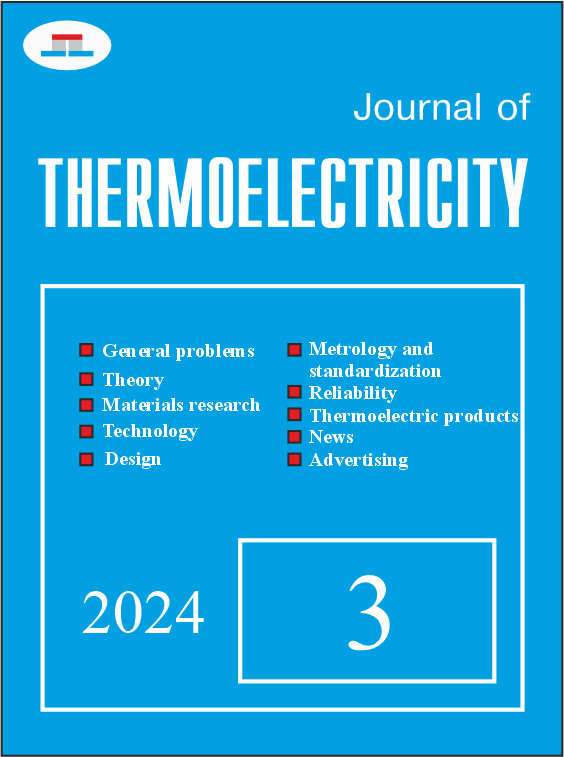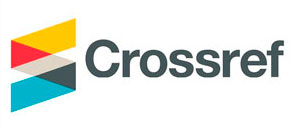Modeling of thermoelectric converter characteristics
Lecture at the Summer Thermoelectric School, June 30, 2024, Krakow, Poland
DOI:
https://doi.org/10.63527/1607-8829-2024-3-5-22Keywords:
thermoelectric converter, thermoelectric module efficiency, methods of optimal control theory, coefficient of performance, electrical contact resistance, thermal resistance of interconnect and insulating platesAbstract
Under the rough estimation the annual worldwide production of thermoelectric converters (modules) for the needs of thermoelectric power generation and cooling reaches more than 50 million pieces. The thermoelectric convertors are mechanically stable, high-reliable with a life cycle up to 20 years. The main disadvantage is their low energy efficiency. This especially applies to miniature modules with a length of thermoelements in the range from 500 mm down to 200 mm. Their low efficiency is due to the effect of electrical and thermal resistances of contacts, interconnectors and insulating plates. One way to improve the efficiency of thermoelectric generators and coolers is to optimize the materials and structure of thermoelectric modules for the required operating conditions. For this purpose, it is advisable to use methods of optimal control theory. They are suitable for optimizing single- and multi-stage converters made of homogeneous or inhomogeneous, so-called functionally graded thermoelectric materials (FGTM). The optimal control method makes it possible to take into consideration the temperature dependences of the thermoelectric parameters of materials, additional bulk thermoelectric effects that occur in FGTMs, and the influence of unwanted electrical and thermal resistances in modules. This lecture outlines the main concepts of the optimal control theory and explains how to use them to design modules with optimal structure and simulate module characteristics. Examples of modeling the convertor performances are considered and the effect of undesirable electrical and thermal resistances on the maximum efficiency of cooling and generating converters made of Bi2Te3-based materials is analyzed. It is shown that the efficiency of modules, especially of miniature ones, can be significantly improved if these unwanted resistances are reduced to their rational values. The decrease in electrical contact resistance is the predominant factor. The rational values to which it is advisable to decrease the electrical contact resistivity have been determined. It is necessary to focus on such rational contact resistance values in the development of modules’ technology. Bibl. 9, Figs. 9, Tabl. 2.
References
1. Salah, W.A., Abuhelwa, M. (2020). Review of thermoelectric cooling devices recent applications. J Eng Sci Technol 15(1), 455–76.
2. Dunham, M.T., Barako, M.T., LeBlanc, S., Asheghi-Roudheni, M., Chen, B., Goodson, K. (2013). Modeling and optimization of small thermoelectric generators for low-power electronics. In Proceedings of the ASME 2013 International Technical Conference and Exhibition on Packaging and Integration of Electronic and Photonic Microsystems. Volume 1: Burlingame, California, USA. July 16–18, 2013.
3. Scott, A., Whalen, C. A., Apblett, T. L. (2008). Improving power density and efficiency of miniature radioisotopic thermoelectric generators, J Power Sources, 180, 657-663.
4. Qian Xu, Biao Deng, Lenan Zhang, Shaoting Lin, et al. (2022). High-performance, flexible thermoelectric generator based on bulk materials, Cell Reports Physical Science, 3(3), 100780.
5. Vikhor, L., Kotsur, M. (2023). Evaluation of efficiency for miniscale thermoelectric converter under the influence of electrical and thermal resistance of contacts. Energies, 16, 4082.
6. Ioffe, A.F. (1957). Semiconductor thermoelements and thermoelectric cooling; Infosearch Limited: London, UK, 184 pp.
7. Anatychuk, L.I. (2003). Thermoelectricity. Volume 2. Thermoelectric energy convertors. Institute of Thermoelectricity: Chernivtsi, Ukraine, 348 pp.
8. Anatychuk, L. I. and Vikhor, L. N. (2012). Thermoelectricity. Volume IV. Functionally graded thermoelectric materials. Institute of Thermoelectricity, Chernivtsi, Ukraine, 172 pp.
9. He, H., Wu, Y., Liu,W., Rong, M., Fang, Z., Tang, X. (2019). Comprehensive modeling for geometric optimization of a thermoelectric generator module. Energy Convers. Manag. 183, 645–659.




